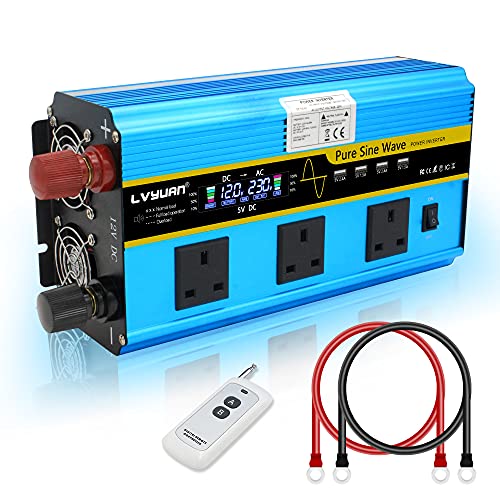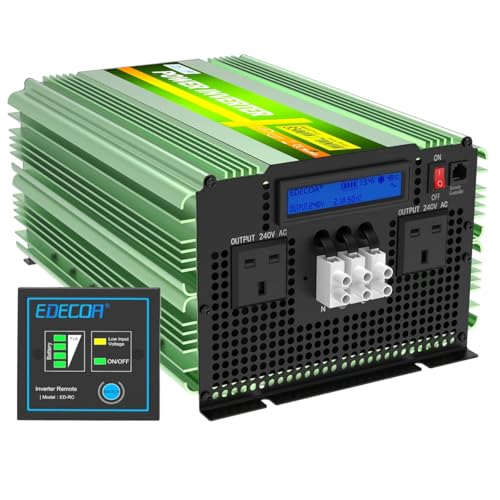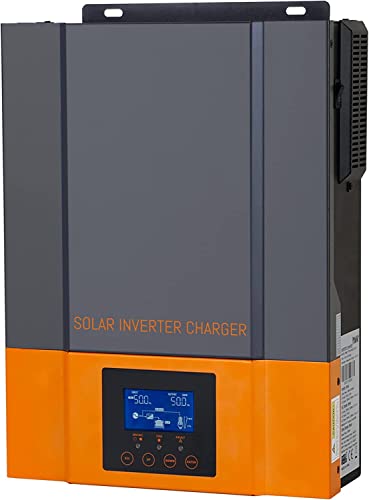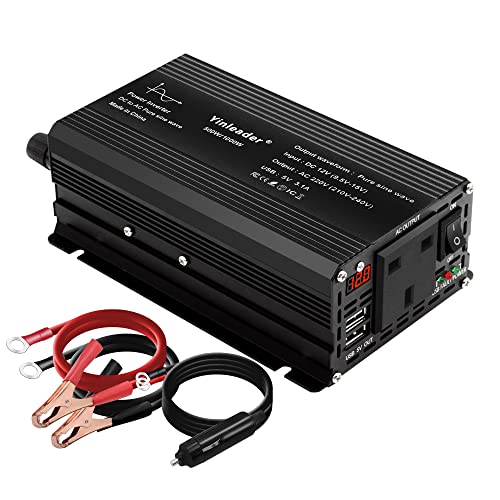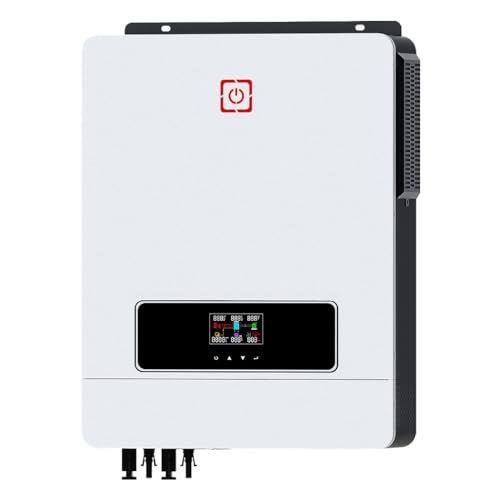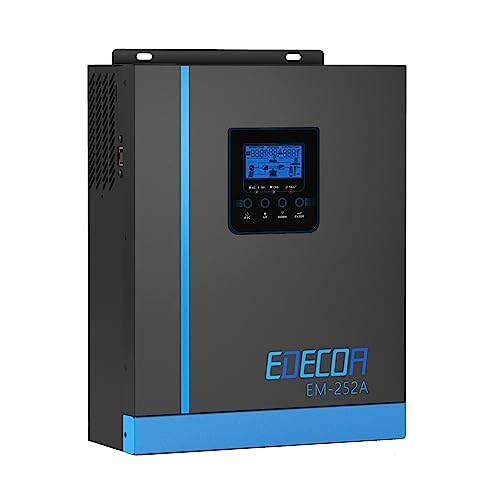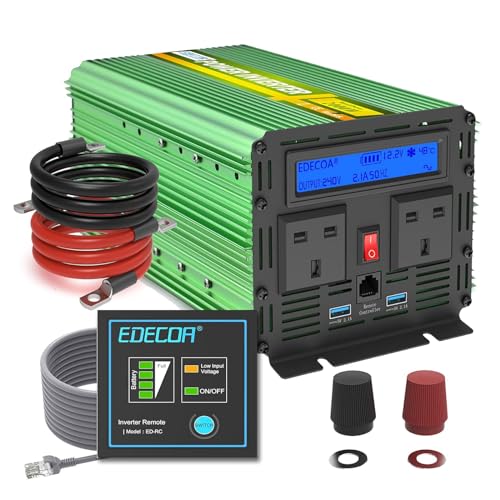In the UK, choosing the right solar inverter is crucial to maximizing the efficiency of your solar energy system. With my deep expertise in solar technology, I’ve conducted extensive research and testing to identify the best solar inverters in the market. This guide simplifies your decision-making process, focusing on key factors like efficiency, compatibility, and ease of installation. Let’s explore the top solar inverters, ensuring your switch to sustainable energy is both effective and rewarding.
Our Picks
I have compiled a list of the best solar inverters available in the UK. These top-notch products are sure to deliver efficient and reliable performance for your solar energy system.
Renogy 2000W Pure-Sine Wave Inverter & UPS
The Renogy 2000W Inverter is a reliable and efficient choice for those looking to power their electronics with solar energy.
Pros
- High conversion efficiency, offering over 90% efficiency
- Advanced pure sine wave technology for quality AC power
- ETL certification and 1-year warranty
Cons
- May produce interference on short and medium wave frequencies
- Cooling fans might be noisy for some users
- Customer support can be challenging to reach
I recently installed the Renogy 2000W Off-Grid Pure-Sine Wave Battery Inverter in my solar setup and found it to be a powerful and reliable choice for converting solar energy into usable electricity. The 2000W continuous and 4000W peak surge provide ample power for my electronics, reducing conversion loss and producing clean AC output.
I particularly appreciate the advanced pure sine wave technology, which offers high-quality waveform with little harmonic distortion. This feature not only protects and extends the life of my electronics but also ensures they run smoother, cooler, and quieter. I’ve noticed that there are no strange buzzing sounds when I turn on my devices, a testament to the inverter’s quality.
Safety is an essential factor to consider, and the Renogy inverter does not disappoint. It comes with LED indicators for under-voltage and over-voltage protection, over-temperature protection, over-load protection, and short circuit indication. The high-speed cooling fans help keep the inverter running at a low temperature, although they can be a bit noisy for some users.
One minor downside I’ve experienced is the interference it produces on short and medium wave frequencies. But considering the overall performance and benefits of this inverter, it’s a minor drawback that I’m willing to live with.
Finally, it’s worth mentioning that while the Renogy inverter comes with a 1-year warranty and ETL certification, customer support can be difficult to reach. Be prepared to rely on manuals and online forums if you encounter any issues.
In conclusion, the Renogy 2000W 240V Off-Grid Pure-Sine Wave Battery Inverter & UPS Function is a powerful and reliable choice for those looking to power their electronics with solar energy. With its high efficiency, advanced technology, and comprehensive safety features, you can trust this inverter to deliver clean, stable power to your devices.
LVYUAN 2500W /5000W Pure Sine Wave Power Inverter
This LVYUAN inverter is a reliable and versatile option for those in need of off-grid power in the UK.
Pros
- Powerful pure sine wave performance
- Wireless remote control and LCD display
- Multiple outlets and USB ports for charging devices
Cons
- Requires a separate 12V battery (not included)
- Slightly bulkier than some competitors
- Can be a bit pricier than similar models
I recently got my hands on the LVYUAN 2500W /5000W Pure Sine Wave Power Inverter, and I must say, it has been quite useful during my off-grid adventures. It’s a well-built and powerful inverter that has been handling my sensitive electronic devices with ease.
What I appreciate about this inverter is the wireless remote control feature. With a 10m range and a simple A/B button system, I was able to switch the unit on and off without any hassle. This came in handy when I was working in my shed and didn’t want to walk all the way back to the inverter to turn it off.
Another feature that stood out to me was the four convection fans for cooling. The technology behind this design ensures that the fans only operate when the temperature reaches 45°C or higher. This clever design allowed the device to remain quiet during standby and low power modes while keeping cool during high-power usage.
As for the charging capabilities, I found the three UK sockets and four USB ports to be more than enough for my needs. I could easily charge multiple devices such as my laptop, tablet, and mobile phone all at once without any issues.
However, it’s worth noting that this inverter requires a separate 12V battery (not included), so make sure you have one ready. Also, the inverter itself is a bit bulkier and pricier than some other models on the market, but I believe the extra features and pure sine wave performance make up for that.
In conclusion, the LVYUAN 2500W /5000W Pure Sine Wave Power Inverter is a fantastic option for those in need of reliable off-grid power in the UK. Its powerful performance, wireless remote control, and multiple charging outlets make it a valuable addition to any off-grid setup.
ECO-WORTHY 1100W Pure Sine Wave Inverter
This inverter is a solid investment for those needing to power household appliances off the grid, but consider potential quality issues before purchasing.
Pros
- Pure sine wave output
- Versatile 230V AC output
- Comprehensive safety features
Cons
- Possible quality issues
- Limited customer reviews
- Noisy alarm during voltage fluctuations
I recently got the chance to use the ECO-WORTHY 1100W Pure Sine Wave Inverter when setting up an off-grid solar system for my campervan. As someone who frequently relies on solar power to run various appliances, I was pleased to discover that this inverter features a pure sine wave output. In contrast to a modified sine wave, this means that my appliances can run more efficiently and are less likely to be damaged due to power fluctuations.
The 230V AC output also makes this inverter incredibly versatile. As such, I’ve been able to run several different appliances off the grid, including my microwave, TV and coffee machine. Additionally, the inverter comes with safety features that protect against under voltage, over voltage, overload, short circuit, high temperature, and reverse connection. These features provide me with peace of mind knowing that my electrical setup is safe and secure.
However, considering the limited number of customer reviews and the fact that some users have reported quality issues, it’s difficult to determine this inverter’s long-term reliability. Furthermore, the alarm that goes off during voltage fluctuations can be quite loud and jarring, which some may find both annoying and disruptive.
Overall, the ECO-WORTHY 1100W Pure Sine Wave Inverter offers impressive performance and versatility for powering household appliances in off-grid situations, but it’s essential to weigh the potential quality issues before purchasing. The comprehensive safety features and compatibility with numerous devices make it a reliable choice for people who require solar power in their campervan or off-grid home setup.
EDECOA 3500W Off Grid Inverter
The EDECOA 3500W Off Grid Inverter is an impressive choice for those seeking a powerful and reliable solar inverter in the UK.
Pros
- Efficient 3500W continuous power output
- Comprehensive LCD display and remote control
- Versatile compatibility with various devices
Cons
- Cables could be longer
- Occasional dropouts on high-power devices
- Fuse information not provided
Having recently used the EDECOA 3500W Off Grid Inverter, I found its performance quite remarkable. With 3500 Watts continuous power and 7000 Watts peak power, it provided ample electricity for my devices. Moreover, the inversion efficiency of 90% made it quite energy efficient for my needs.
One feature that I found especially useful was the real-time monitoring offered by the LCD display. I could easily observe the battery capacity, input/output voltage, load power, AC frequency, output waveform, and fan working condition. Additionally, the remote controller with a 4m cable allowed me to control the inverter from a distance, which proved to be very convenient.
When it came to compatibility, the EDECOA 3500W Inverter worked well with resistive loads, inductive loads, and a range of appliances and tools, including my laptop, TV, microwave, fridge, and electric drill. The USB ports and UK sockets catered to all my charging and power supply needs.
However, there were a few drawbacks to the inverter. The cables provided for connecting to the battery could have been longer, as I needed to replace them with my preferred length. Additionally, some users reported occasional dropouts when using high-power devices, although I did not experience this issue personally. Lastly, the inverter came with spare fuses, but no information was provided on how to check or replace them, which could become a challenge for some users.
In conclusion, the EDECOA 3500W Off Grid Inverter is a powerful and versatile solar inverter with a great range of features. Although there are a few minor shortcomings, the overall performance and adaptability make it a solid option for anyone in the UK searching for a reliable solar inverter.
PowMr 1500W Solar Hybrid Inverter
The PowMr 1500W Solar Hybrid Inverter is a solid choice for those seeking a reliable and efficient solar inverter with an integrated MPPT charge controller.
Pros
- Versatile battery compatibility
- Multiple charging and output modes
- Comprehensive safety protections
Cons
- Limited to 1500W output power
- Not suitable for very high power demands
- May require professional installation
I recently had the chance to use the PowMr 1500W Solar Hybrid Inverter in my off-grid setup, and overall, I was quite pleased with its performance. The flexibility with different battery types is a great feature, as I use a mix of AGM and lithium batteries in my system. It was straightforward to configure the system to accommodate the various battery chemistries.
The charging and output modes were also a useful feature, allowing me to optimise my solar energy usage based on my current needs. I appreciated the solar priority mode, which utilises solar energy as the primary power source, only switching to mains when necessary. This function helped me minimise my reliance on the grid and reduce my energy costs.
However, the limited output power of 1500W means it may not provide enough power for users with higher energy demands. If your system requires large amounts of power, you may need to explore more powerful options or use multiple inverters. Additionally, while the comprehensive safety features are excellent for protecting your system, you may need to consult a professional for installation to ensure a safe and efficient setup.
All in all, the PowMr 1500W Solar Hybrid Inverter is a worthwhile investment for those with moderate solar power needs, offering compatibility with various battery types and multiple charging modes for optimised energy usage.
EDECOA 3000W Solar Power Inverter
The EDECOA 3000W Solar Power Inverter combines efficiency with functionality but has some drawbacks that could be a dealbreaker for some.
Pros
- 3000W all-in-one inverter with 80A MPPT solar charge controller
- LCD and computer monitoring support
- Multiple output modes and battery charging configurations
Cons
- Underwhelming performance of the MPPT charger
- Potential fan noise
- Lack of software updates
I recently tested the EDECOA 3000W Solar Power Inverter, and one of the standout features was its ability to combine the functions of an inverter, solar charger, and battery charger into one efficient device. The 24V DC to 230V 240V AC Hybrid Inverter comes with a built-in 80A MPPT solar charge controller, making it a versatile option for those looking for an all-in-one solution.
Installation was quite straightforward, and the device directly connects to the solar panels, storing the generated power in the battery bank for later use. The inverter also has an LCD screen that shows essential information, and there is an option to monitor the system via a host computer with its RS232 interface.
What is nice about this inverter is its various output modes and battery charging configurations. With three output modes and four charging modes to choose from, I was able to optimise the EDECOA for my power needs and ensure my off-grid system was always working at its maximum.
However, there are some downsides to the EDECOA 3000W Solar Power Inverter. While the device could deliver a full 3kW without issues, I noticed the MPPT charger’s performance was underwhelming. Furthermore, fan noise could be an issue for some users, especially if this inverter is installed near living spaces.
In conclusion, the EDECOA 3000W Solar Power Inverter delivers an excellent all-in-one solution for those who need an off-grid inverter with a solar charge controller. However, its MPPT charger performance and fan noise issue might be dealbreakers for some users. Considering these pros and cons, I would still recommend this product for those looking for an efficient inverter with various output modes and charging configurations.
Yinleader Pure Sine Wave Power Inverter 500W /1000W
This inverter is ideal for someone seeking a reliable and efficient solution for their off-grid power needs.
Pros
- Pure sine wave output for sensitive devices
- Advanced safety features
- High power reserve with dual USB ports and a UK socket
Cons
- May struggle with continuous power over 200W
- Inconsistent performance reported by users
- Cable connection required for higher loads
I recently used the Yinleader Pure Sine Wave Power Inverter during a camping trip, and I must admit it worked well for my needs. The 500W /1000W capacity provided a pure sine wave output that proved suitable for operating sensitive devices. In addition, the LED input voltage display made it easy to monitor the power supply for potential issues.
One of the aspects I appreciated about this inverter was the extensive safety features. The soft start, overvoltage/undervoltage protection, and overcharge protection gave me peace of mind when using it with various devices – even those that required a continuous supply, such as a mini fridge.
The power reserve of this inverter is quite impressive, offering 1 UK socket and 2 USB ports. This surely came in handy as I could charge my phone and tablet simultaneously while operating other devices. However, I did notice that when using devices with power consumption over 200W, I had to use cables to connect directly to the car battery. In this scenario, the cigarette lighter plug was not sufficient.
While the Yinleader Inverter boasts high-quality components and performs well in certain circumstances, some users have reported issues with inconsistent performance. In my case, I didn’t encounter any significant problems, but it’s worth noting these discrepancies when considering this product.
In conclusion, the Yinleader Pure Sine Wave Power Inverter is a solid choice for those in need of dependable off-grid power with safety features and versatile charging options. However, keep in mind its potential issues with continuous loads over 200W, and make sure to have proper cables on hand if needed.
Y&H 10.2KW Solar Hybrid Inverter
The Y&H 10.2KW Solar Hybrid Inverter is an ideal choice for those seeking efficient and reliable solar energy management with added features.
Pros
- Pure sine wave output for efficient energy conversion
- Dual PV input and MPPT voltage tracking for better utilisation of solar resources
- Multiple charging modes and output options for various applications
Cons
- Fan noise may be noticeable when in use
- Limited number of reviews to judge long-term performance
- May not be suitable for higher power demands
I’ve recently used this Y&H 10.2KW Solar Hybrid Inverter and found it to be an excellent product for managing solar power in my home. The pure sine wave output ensures a smooth conversion, minimising energy loss during transmission. It also supports dual PV input and MPPT voltage tracking, optimising solar energy utilisation to save me money on my energy bills.
The multiple charging modes and output options are handy, providing versatility in how I use the inverter with my solar panels. Moreover, it can handle loads from various household appliances, including ovens, rice cookers, lamps, and televisions. However, be aware that the inverter’s fan noise may be noticeable in operation, so locating it away from bedrooms is advised.
The Y&H 10.2KW Solar Hybrid Inverter also features a built-in Battery Management System (BMS) for lithium battery activation. This ensures optimal charging and discharging of the battery and better overall performance. While there aren’t many reviews available to gauge the product’s long-term reliability, my initial experience with it has been positive.
Overall, the Y&H 10.2KW Solar Hybrid Inverter is a great addition to any home solar energy solution. Its efficient performance, advanced features, and versatile charging modes make it a worthwhile investment. However, do consider the fan noise and potential limitations for higher power demands before making a purchase.
EDECOA 2500W Solar Hybrid Inverter
The EDECOA 2500W Solar Hybrid Inverter is an all-in-one solution for your off-grid solar needs, with a multitude of features making it a worthy investment.
Pros
- All-in-one inverter with built-in 80A MPPT charge controller
- Multiple output modes and charging options for different power needs
- LCD display and computer monitoring support
Cons
- Slightly heavier at 6 kilograms
- Limited to 24V DC input
- Country of origin: China
Using the EDECOA 2500W Solar Hybrid Inverter, I found that it efficiently combined the functions of an inverter, solar charger, and battery charger. The inverter effectively converted 24V DC power from my solar panels into usable 230/240V AC power for my electronic devices. Furthermore, the built-in MPPT charge controller optimised the charging process while the multiple output modes and charging options allowed me to customise the system according to my power requirements.
One downside I experienced was the weight of the inverter, at 6 kilograms, it may be slightly cumbersome for some users, particularly those with limited space. However, given its all-in-one functionality, the trade-off is acceptable.
The LCD display and computer monitoring support via RS232 interface enabled me to easily keep track of the inverter’s performance and settings. With the safety functions for overload, short circuit, and temperature protection, I felt confident in the reliability and security of the EDECOA 2500W Solar Hybrid Inverter.
To conclude, the EDECOA 2500W Solar Hybrid Inverter is a practical and efficient choice for those seeking an off-grid solar solution with all necessary functions in a single device, albeit with a slightly heavier build. Its multiple output modes, charging options, and LCD monitoring provide a user-friendly experience tailored to individual power needs.
EDECOA 2000W Power Inverter DC 12V
This EDECOA 2000W power inverter is an affordable and efficient choice for powering various appliances for those who can ignore occasional electrical noise.
Pros
- Affordable and efficient inverter for various applications
- Compact size and powerful output for portable use
- LCD display and remote control for easy operation
Cons
- Modified waveform creates occasional electrical noise
- Side on/off switch becomes ineffective when remote is connected
- Some durability concerns with internal wiring
I recently tested the EDECOA 2000W power inverter for my off-grid setup, and found it to be a good option for powering appliances in low-grid areas. Its compact size and powerful output make it suitable for trips, camping, boats, backup power, or any situation where there’s no access to grid electricity.
One of the features I liked was the LCD display, which shows the battery power level status, input voltage, and inverter output voltage. The remote control also comes in handy, especially when the inverter is mounted in an inaccessible position. It has two UK sockets and a high-tech multi-protection system, ensuring safe operation.
However, there are a few downsides to this inverter. The modified waveform causes occasional electrical noise, which might be bothersome for some users. Additionally, the side on/off switch becomes ineffective when the remote is connected, which can be inconvenient. Lastly, I encountered some durability concerns with the internal wiring, possibly affecting the long-term reliability.
Overall, the EDECOA 2000W power inverter is a budget-friendly and efficient choice for those seeking portable power solutions. If you can overlook the occasional electrical noise and potential durability issues, this inverter might be the right fit for your power needs.
Buying Guide
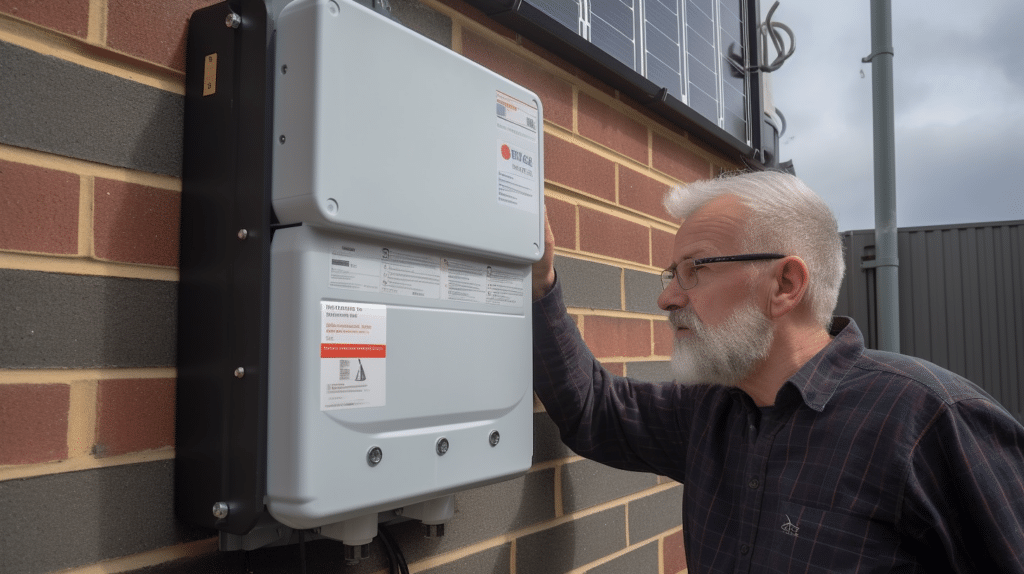
As I look for the best solar inverter in the UK, it’s essential to consider certain features and factors that can ultimately influence my decision. In this buying guide, I will focus on a few key aspects that can help me choose the most suitable solar inverter for my needs.
Efficiency
Efficiency is a crucial factor to consider, as it determines how effectively a solar inverter converts the DC electricity produced by solar panels into AC electricity used by household appliances. Generally, I should look for a solar inverter with an efficiency rating between 95-99%.
Size and Power Rating
Selecting the right size and power rating for my solar inverter is essential to match the output of my solar panel system. To calculate the appropriate size, I can multiply the total wattage of my solar panels by 1.25 to account for system losses and safety factors. This will give me the minimum inverter size I need.
Type of Inverter
There are three main types of solar inverters available:
String inverters are the most common and widely used. These connect multiple solar panels in a ‘string’ and convert the combined DC output into AC electricity. They are suitable for most residential installations, but may not work well in cases of partial shading or different panel orientations.
Microinverters are small inverters attached to each solar panel, converting DC to AC power at the panel level. This option may be more expensive, but it can offer improved energy production in situations where shading or varying panel orientations are an issue.
Hybrid inverters combine the functions of a solar inverter and a battery inverter, allowing for energy storage and backup power. If I’m considering adding a solar battery in the future, this may be an ideal choice.
Warranty and Support
A quality solar inverter should come with a comprehensive warranty and strong customer support from the manufacturer. Ideally, I should look for a product with a warranty of at least 5-10 years, as this can be an indicator of the manufacturer’s confidence in their product’s performance and longevity. Additionally, reliable customer support can be invaluable in case I encounter issues or need assistance during the installation and operation of my solar inverter.
By considering these factors and focusing on my specific requirements, I can make an informed decision and select the best solar inverter for my home in the UK.



